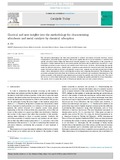Mostrar el registro sencillo del ítem
Classical and new insights into the methodology for characterizing adsorbents and metal catalysts by chemical adsorption
| dc.creator | Gil Bravo, Antonio | es_ES |
| dc.date.accessioned | 2023-04-28T15:52:53Z | |
| dc.date.available | 2023-04-28T15:52:53Z | |
| dc.date.issued | 2023 | |
| dc.identifier.citation | Gil, A. (2023). Classical and new insights into the methodology for characterizing adsorbents and metal catalysts by chemical adsorption. Catalysis Today, S0920586123000238. https://doi.org/10.1016/j.cattod.2023.01.023 | en |
| dc.identifier.issn | 0920-5861 | |
| dc.identifier.uri | https://hdl.handle.net/2454/45190 | |
| dc.description.abstract | The adsorption phenomenon has been used extensively to achieve and explain solid-state reactions, control contamination, and purify liquids and gases. This process implies the use of a porous medium or a material with specific adsorption centers where the interactions with the reagents occur. Determination of the properties of adsorbent or catalyst materials that do not contain specific adsorption sites by physical gas adsorption is a well-established procedure in most research and quality-control laboratories. However, characterizing the specific centers by selective adsorption—chemisorption—remains an open question for discussion and study. The specific centers involved are often acidic/basic and metallic; in most cases, reagents are adsorbed and desorbed in these centers, whose determination allows controlling the processes and comparing the materials. The techniques and procedures presented herein facilitate the evaluation and the qualitative and quantitative determination of the surface properties of the materials using chemisorption processes for metallic and acidic/basic sites. The aim of this work is to review these techniques and procedures, including the updates published by several researchers, who mostly strive to explain the results of bifunctional metallic and acid–base catalytic behavior. | en |
| dc.description.sponsorship | The author is grateful for financial support from the Spanish Ministry of Science and Innovation (AEI/MINECO) and Government of Navarra through projects PID2020-112656RB-C21 and 0011-3673-2021-000004. Open access funding provided by Universidad Pública de Navarra . AG also thanks Santander Bank for funding via the Research Intensification Program. | en |
| dc.format.mimetype | application/pdf | en |
| dc.language.iso | eng | en |
| dc.publisher | Elsevier | en |
| dc.relation.ispartof | Catalysis Today 2023 | en |
| dc.rights | © 2023 The Author(s). Published by Elsevier B.V. This is an open access article under the CC BY-NC-ND D license. | en |
| dc.rights.uri | http://creativecommons.org/licenses/by-nc-nd/4.0/ | |
| dc.subject | Chemical adsorption | en |
| dc.subject | Selective adsorption | en |
| dc.subject | Active sites | en |
| dc.subject | Metallic dispersion | en |
| dc.subject | Metallic surface area | en |
| dc.subject | Acid/base properties | en |
| dc.title | Classical and new insights into the methodology for characterizing adsorbents and metal catalysts by chemical adsorption | en |
| dc.type | Artículo / Artikulua | es |
| dc.type | info:eu-repo/semantics/article | en |
| dc.date.updated | 2023-04-28T15:31:26Z | |
| dc.contributor.department | Ciencias | es_ES |
| dc.contributor.department | Zientziak | eu |
| dc.contributor.department | Institute for Advanced Materials and Mathematics - INAMAT2 | en |
| dc.rights.accessRights | Acceso abierto / Sarbide irekia | es |
| dc.rights.accessRights | info:eu-repo/semantics/openAccess | en |
| dc.identifier.doi | 10.1016/j.cattod.2023.01.023 | |
| dc.relation.projectID | info:eu-repo/grantAgreement/AEI/Plan Estatal de Investigación Científica y Técnica y de Innovación 2017-2020/PID2020-112656RB-C21/ES/ | en |
| dc.relation.projectID | info:eu-repo/grantAgreement/Gobierno de Navarra//0011-3673-2021-000004 | en |
| dc.relation.publisherversion | https://doi.org/10.1016/j.cattod.2023.01.023 | |
| dc.type.version | Versión publicada / Argitaratu den bertsioa | es |
| dc.type.version | info:eu-repo/semantics/publishedVersion | en |
| dc.contributor.funder | Universidad Pública de Navarra / Nafarroako Unibertsitate Publikoa | es |



